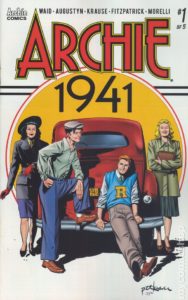 Archie 1941 #1 (of 5) — Writers: Brian Augustyn and Mark Waid; Art: Peter Krause; Colors: Kelly Fitzpatrick
Archie 1941 #1 (of 5) — Writers: Brian Augustyn and Mark Waid; Art: Peter Krause; Colors: Kelly Fitzpatrick
Cemetery Beach #1 (of 7) — Writer: Warren Ellis; Art/Colors: Jason Howard
MCMLXXV #1 — Writer: Joe Casey; Art: Ian Macewan; Colors: Brad Simpson
Moth and Whisper #1 — Writer: Ted Anderson; Art/Colors: Jen Hickman
A ton of good comics were released this week — enough to cover 35 of them here  — so let’s get started: we’ll begin with the indy titles, since they’re such a diverse and high-quality group. Archie 1941 imagines Archie and the crew graduating high school the year they first appeared as comic characters — and, unknowingly, heading straight into WWII. That part’s not in this first issue, of course — Peal Harbor’s still months away — but there’s angst in the air, and co-writer Mark Waid, who had such success helming the first few years of the modern rebooted Archie, knows these characters intimately enough to make it all work, stirring in humor, drama and history to start this mini-series off right. Cemetery Beach is new Warren Ellis, paired with his Trees collaborator Jason
— so let’s get started: we’ll begin with the indy titles, since they’re such a diverse and high-quality group. Archie 1941 imagines Archie and the crew graduating high school the year they first appeared as comic characters — and, unknowingly, heading straight into WWII. That part’s not in this first issue, of course — Peal Harbor’s still months away — but there’s angst in the air, and co-writer Mark Waid, who had such success helming the first few years of the modern rebooted Archie, knows these characters intimately enough to make it all work, stirring in humor, drama and history to start this mini-series off right. Cemetery Beach is new Warren Ellis, paired with his Trees collaborator Jason 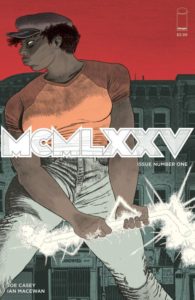 Howard. To quote from a character’s info-dump on page two: “…around 1920, a group of industrialists and scientists found and operated a method to travel off-world. An off-world colony was established some ten years later, and has been receiving intermittent resupplies ever since….” That narrator is an advance scout from Earth investigating the mysterious colony, and of course things go awry, leading to a partnership with a kick-ass woman prisoner and a long, detailed chase scene: vintage Ellis, in other words, and a briskly-paced, good-looking debut. MCMLXXV (that’s 1975, if you never learned Roman numerals…), set in that year, is about an NYC cabdriver who’s female, African-
Howard. To quote from a character’s info-dump on page two: “…around 1920, a group of industrialists and scientists found and operated a method to travel off-world. An off-world colony was established some ten years later, and has been receiving intermittent resupplies ever since….” That narrator is an advance scout from Earth investigating the mysterious colony, and of course things go awry, leading to a partnership with a kick-ass woman prisoner and a long, detailed chase scene: vintage Ellis, in other words, and a briskly-paced, good-looking debut. MCMLXXV (that’s 1975, if you never learned Roman numerals…), set in that year, is about an NYC cabdriver who’s female, African-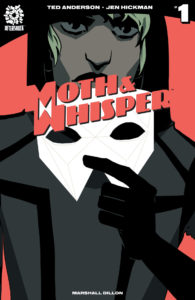 American, in a relationship with a popular late-night DJ, and beats up demons with a glowing enchanted tire iron; get it because it’s Joe Casey doing an imaginative mashup of Mean Streets, Wonder Woman and Mage, and because Ian Macewan’s loose, gritty urban style’s able to handle the fantasy elements just as well, too. Moth and Whisper is about a city with those two title super-thieves/sort-of heroes, one a master of disguise and the other a ninja-like stealth expert; they’ve disappeared, and this first issue establishes their relationship and their legacy. It’s solid, with a likable and sympathetic lead character and enough cool ideas and world-building to do its job of bringing readers back for a second helping.
American, in a relationship with a popular late-night DJ, and beats up demons with a glowing enchanted tire iron; get it because it’s Joe Casey doing an imaginative mashup of Mean Streets, Wonder Woman and Mage, and because Ian Macewan’s loose, gritty urban style’s able to handle the fantasy elements just as well, too. Moth and Whisper is about a city with those two title super-thieves/sort-of heroes, one a master of disguise and the other a ninja-like stealth expert; they’ve disappeared, and this first issue establishes their relationship and their legacy. It’s solid, with a likable and sympathetic lead character and enough cool ideas and world-building to do its job of bringing readers back for a second helping.
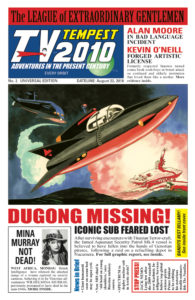 League of Extraordinary Gentlemen: The Tempest #2 (of 6) — Writer: Alan Moore; Art: Kevin O’Neill; Colors: Ben Dimagmaliw
League of Extraordinary Gentlemen: The Tempest #2 (of 6) — Writer: Alan Moore; Art: Kevin O’Neill; Colors: Ben Dimagmaliw
The New World #3 (of 5) — Writer: Ales Kot; Art: Tradd Moore; Colors: Heather Moore
The Seeds #2 (of 4) — Writer: Ann Nocenti; Art: David Aja
Hey Kids! Comics! #2 — Writer/Artist: Howard Chaykin; Colors: Wil Quintana
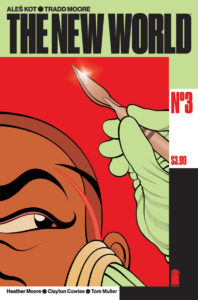 Crowded #2 — Writer: Christopher Sebela; Pencils: Ro Stein; Inks: Ted Brandt; Colors: Triona Farrell
Crowded #2 — Writer: Christopher Sebela; Pencils: Ro Stein; Inks: Ted Brandt; Colors: Triona Farrell
Farmhand #3 — Writer/Artist: Rob Guillory; Colors: Taylor Wells
She Could Fly #3 (of 4) — Writer: Christopher Cantwell; Art: Martin Morazzo; Colors: Miroslav Mrva
Lots of newish indy books (on their third issue or less) are 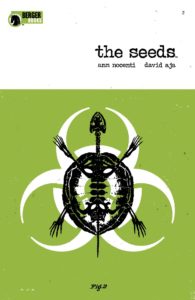 out this week, too. League of Extraordinary Gentlemen: The Tempest is the final volume of that long-running Alan Moore/Kevin O’Neill pulp-character team-up; the dense style, call-backs to previous adventures and references to both British and American pop fiction from the last century are a lot easier to understand if you’ve read previous installments of the series, although the storytelling’s good enough to carry you along regardless. The New World is a brightly-colored sf story about a rebel and a cop who inexplicably fall in love,
out this week, too. League of Extraordinary Gentlemen: The Tempest is the final volume of that long-running Alan Moore/Kevin O’Neill pulp-character team-up; the dense style, call-backs to previous adventures and references to both British and American pop fiction from the last century are a lot easier to understand if you’ve read previous installments of the series, although the storytelling’s good enough to carry you along regardless. The New World is a brightly-colored sf story about a rebel and a cop who inexplicably fall in love,  and their attempts to get out of the dystopian society that now wants to kill both of them; it’s surprisingly funny and straightforwardly heartfelt for an Ales Kot book, and the Tradd Moore art (and Heather Moore coloring) make it a technicolor manga-punk delight. The Seeds has nice art, too, with David Aja using a detailed, shadowy duo-tone style to tell Ann Nocenti’s just-pre-apocalyptic tale about aliens coming to Earth to gather samples of its life forms before its polluted and global-warmed environment collapses into an extinction event; the trick is that this is told on a micro-
and their attempts to get out of the dystopian society that now wants to kill both of them; it’s surprisingly funny and straightforwardly heartfelt for an Ales Kot book, and the Tradd Moore art (and Heather Moore coloring) make it a technicolor manga-punk delight. The Seeds has nice art, too, with David Aja using a detailed, shadowy duo-tone style to tell Ann Nocenti’s just-pre-apocalyptic tale about aliens coming to Earth to gather samples of its life forms before its polluted and global-warmed environment collapses into an extinction event; the trick is that this is told on a micro-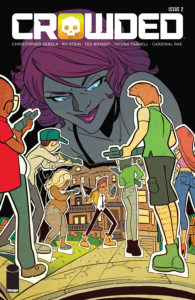 scale, through the viewpoint of a scuffling independent investigative reporter, which grounds and humanizes the cosmic-calamity parts. Hey Kids! Comics! is a second issue, too, although Howard Chaykin’s thinly-disguised, gossipy look at the comics industry jumps around so much in time — with scenes from 1945, 1955, 1965 and 2001 — that it might not matter what order you read it in. Come for the detailed, historically-accurate art and the insider’s view of the industry; stay to figure out which real-life creators are being analyzed and (sometimes) skewered (Stan Lee and Jack Kirby are easy to spot, but
scale, through the viewpoint of a scuffling independent investigative reporter, which grounds and humanizes the cosmic-calamity parts. Hey Kids! Comics! is a second issue, too, although Howard Chaykin’s thinly-disguised, gossipy look at the comics industry jumps around so much in time — with scenes from 1945, 1955, 1965 and 2001 — that it might not matter what order you read it in. Come for the detailed, historically-accurate art and the insider’s view of the industry; stay to figure out which real-life creators are being analyzed and (sometimes) skewered (Stan Lee and Jack Kirby are easy to spot, but 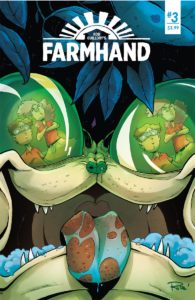 some of the others are combinations; Gil Kane, Will Eisner, Matt Baker, Martin Goodman, Ramona Fradon and Todd McFarlane (or maybe Rob Liefeld) are all in there, too. Crowded is about a near-future where, if someone’s really annoying, you can crowd-fund a one-month open hit on them via social media; that’s the high concept, but it’s really an excuse to do a buddy comedy/action flick between two women: the object of the hit, who’s considerably less innocent than she seems, and the matter-of-fact bodyguard/mercenary who’s trying to protect her, and who also has secrets. Twisty plotting, with intriguing and well-rounded characters drawn in a appealingly-cartoony style by Ro Stein, make this easy to like. Farmhand has a gonzo concept, too — a scientist
some of the others are combinations; Gil Kane, Will Eisner, Matt Baker, Martin Goodman, Ramona Fradon and Todd McFarlane (or maybe Rob Liefeld) are all in there, too. Crowded is about a near-future where, if someone’s really annoying, you can crowd-fund a one-month open hit on them via social media; that’s the high concept, but it’s really an excuse to do a buddy comedy/action flick between two women: the object of the hit, who’s considerably less innocent than she seems, and the matter-of-fact bodyguard/mercenary who’s trying to protect her, and who also has secrets. Twisty plotting, with intriguing and well-rounded characters drawn in a appealingly-cartoony style by Ro Stein, make this easy to like. Farmhand has a gonzo concept, too — a scientist 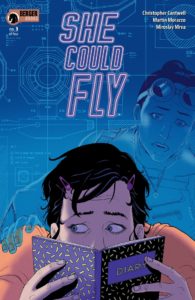 discovers a way to grow human organs like corn, but, as anyone who’s seen Jurassic Park will tell you, weird science can lead to bad outcomes — and Guillory, the former artist on the similarly-high-concept Chew, is just the guy to make it work. She Could Fly is about a high-school girl struggling with OCD-related problems who gets obsessed about news reports about a mysterious flying girl, and ends up entangled with the creator of a prototype harness who’s being chased by all manner of bad guys and black-ops agents; at issue three of a four-part story, it could be just OK or very good, depending on how it sticks the landing next issue.
discovers a way to grow human organs like corn, but, as anyone who’s seen Jurassic Park will tell you, weird science can lead to bad outcomes — and Guillory, the former artist on the similarly-high-concept Chew, is just the guy to make it work. She Could Fly is about a high-school girl struggling with OCD-related problems who gets obsessed about news reports about a mysterious flying girl, and ends up entangled with the creator of a prototype harness who’s being chased by all manner of bad guys and black-ops agents; at issue three of a four-part story, it could be just OK or very good, depending on how it sticks the landing next issue.
 World of Tanks: Citadel #5 (of 5) — Writer: Garth Ennis; Art: P.J. Holden; Colors: Michael Atiyeh
World of Tanks: Citadel #5 (of 5) — Writer: Garth Ennis; Art: P.J. Holden; Colors: Michael Atiyeh
The Wicked and the Divine #39 — Writer: Kieron Gillen; Art: Jamie McKelvie; Colors: Matthew Wilson
B.P.R.D.: The Devil You Know #10 (Legacy #157) — Writers: Mike Mignola and Scott Allie; Art: Laurence Campbell; Colors: Dave Stewart
Head Lopper #9 — Writer/Artist — Andrew Maclean;  Colors: Jordie Bellaire
Colors: Jordie Bellaire
Mage: The Hero Denied #12 (of 15) — Writer/Artist: Matt Wagner; Colors: Brennan Wagner
World of Tanks concludes a Garth Ennis/P.J. Holden war comic about the WWII Battle of Kursk; it’s focused on the tank crews of both sides, German and Russian, and weaves a good, non-stereotypical story about both in among the historical accuracies and discussions of tank-based  strategy. If you like war comics at all, Ennis is very good at them, and this is no exception. The Wicked and the Divine ends its penultimate arc with a couple more revelations (it ‘s had a lot of them), and the usual clear, attractive art by Jamie McKelvie. It’s taking a few months off before the final volume, so this is a good time to get caught up; if you liked the Gillen/McKelvie Young Avengers from a few years ago, this has the same focus on powered twenty-somethings and their various conspiracies, problems and hook-ups, except
strategy. If you like war comics at all, Ennis is very good at them, and this is no exception. The Wicked and the Divine ends its penultimate arc with a couple more revelations (it ‘s had a lot of them), and the usual clear, attractive art by Jamie McKelvie. It’s taking a few months off before the final volume, so this is a good time to get caught up; if you liked the Gillen/McKelvie Young Avengers from a few years ago, this has the same focus on powered twenty-somethings and their various conspiracies, problems and hook-ups, except 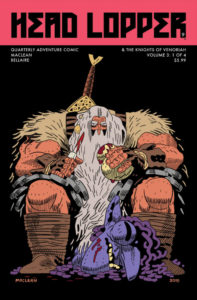 darker and deadlier (the characters get godlike powers for two years, and then are guaranteed to die), and it’s been an exciting, unpredictable ride. B.P.R.D. has been a roller-coaster trip, too, and has been doing it for much longer (157 issues and counting, spread out over a number of mini- and maxi-series); it’s also entering its last arc ever, and with Hellboy back, and a major villain reveal on the last page, it’s promising a lot of possibly-Armegeddonesque adventure over the next few months. If you’ve read it in past decades and lapsed, this is a good time to check out the finale. A
darker and deadlier (the characters get godlike powers for two years, and then are guaranteed to die), and it’s been an exciting, unpredictable ride. B.P.R.D. has been a roller-coaster trip, too, and has been doing it for much longer (157 issues and counting, spread out over a number of mini- and maxi-series); it’s also entering its last arc ever, and with Hellboy back, and a major villain reveal on the last page, it’s promising a lot of possibly-Armegeddonesque adventure over the next few months. If you’ve read it in past decades and lapsed, this is a good time to check out the finale. A  new Head Lopper is always cause for celebration; Andrew Maclean’s barbarian fever dream, which looks like Conan as drawn by Moebius, begins with some backstory on Agatha (the talking witch’s head that the title character carries around in a sack), and then gets its wandering hero involved in local palace intrigue, and is just as colorful, action-packed and fun as ever. Mage, at the 80% mark of its final volume, ups the action too, as Kevin, with his daughter, searches for his captured wife and son, who are making their own escape attempt; it’s yet another book that ends with a major character reveal on the last page — one of special interest to readers who’ve been around since the book’s beginnings, back in 1984.
new Head Lopper is always cause for celebration; Andrew Maclean’s barbarian fever dream, which looks like Conan as drawn by Moebius, begins with some backstory on Agatha (the talking witch’s head that the title character carries around in a sack), and then gets its wandering hero involved in local palace intrigue, and is just as colorful, action-packed and fun as ever. Mage, at the 80% mark of its final volume, ups the action too, as Kevin, with his daughter, searches for his captured wife and son, who are making their own escape attempt; it’s yet another book that ends with a major character reveal on the last page — one of special interest to readers who’ve been around since the book’s beginnings, back in 1984.
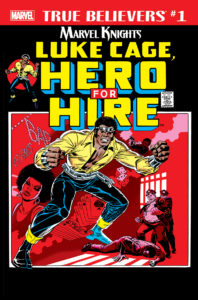 True Believers: Marvel Knights 20th Anniversary: Luke Cage, Hero for Hire #1 (of 1) — Writer: Archie Goodwin; Pencils: George Tuska; Inks: Billy Graham
True Believers: Marvel Knights 20th Anniversary: Luke Cage, Hero for Hire #1 (of 1) — Writer: Archie Goodwin; Pencils: George Tuska; Inks: Billy Graham
True Believers: Marvel Knights 20th Anniversary: Jessica Jones: Alias #1 (of 1) — Writer: Brian Michael Bendis; Art: Michael Gaydos; Colors: Matt Hollingsworth
True Believers: Marvel Knights 20th Anniversary: Daredevil and the Defenders #1 (of 1) — Writer: Brian Michael Bendis; Art: Alex Maleev; Colors: Dave Stewart
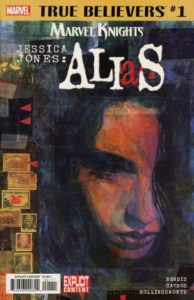 Iceman #1 — Writer: Sina Grace; Art: Nathan Stockman; Colors: Federico Blee
Iceman #1 — Writer: Sina Grace; Art: Nathan Stockman; Colors: Federico Blee
Marvel Rising: Omega #1 (of 1) — Writer: Devin Grayson; Art: Georges Duarte with Roberto di Salvo; Colors: Rachelle Rosenberg
Journey Into Mystery: The Birth of Krakoa #1 (of 1) — Writer: Dennis Hopeless; Art: Djibril Morissette-Phan; Colors: Rachelle Rosenberg
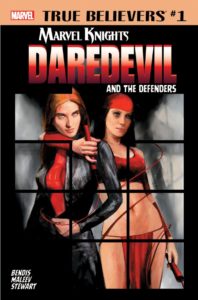 Those $1 “True Believer” titles continue to be cheap quality historic reading; 1973’s debut of Luke Cage isn’t the quick-buck, cluelessly-racist embarrassment you might expect, because it has the luck of being written by Archie Goodwin, who gives Cage a solid origin, a cool villain (Diamondback), an interesting hook, and just enough blaxploitation-movie-era flash, while George Tuska’s ’50s-honed caricatures of corrupt wardens, burly prison guards, desperate inmates and street-level hoods get modernized and grounded by Billy Graham’s inks. The two actual “Marvel Knights” imprint issues are both written by Brian
Those $1 “True Believer” titles continue to be cheap quality historic reading; 1973’s debut of Luke Cage isn’t the quick-buck, cluelessly-racist embarrassment you might expect, because it has the luck of being written by Archie Goodwin, who gives Cage a solid origin, a cool villain (Diamondback), an interesting hook, and just enough blaxploitation-movie-era flash, while George Tuska’s ’50s-honed caricatures of corrupt wardens, burly prison guards, desperate inmates and street-level hoods get modernized and grounded by Billy Graham’s inks. The two actual “Marvel Knights” imprint issues are both written by Brian  Bendis; Alias #1 features him and Michael Gaydos launching the character of hard-boiled investigator Jessica Jones, and is a reminder of just how much of that TV series’s first season came directly from the gritty, R-rated atmosphere they create here. Daredevil and the Defenders reprints the mid-/00’s Daredevil #80, right near the end of a long Bendis/Alex Maleev run that saw Matt Murdoch outed as Daredevil; he’s been shot and, on the run from the authorities and the Hand, ends up getting taken to the newly-reinvented Night Nurse by Elektra and the Black Widow. I’d forgotten just how entertaining these stories
Bendis; Alias #1 features him and Michael Gaydos launching the character of hard-boiled investigator Jessica Jones, and is a reminder of just how much of that TV series’s first season came directly from the gritty, R-rated atmosphere they create here. Daredevil and the Defenders reprints the mid-/00’s Daredevil #80, right near the end of a long Bendis/Alex Maleev run that saw Matt Murdoch outed as Daredevil; he’s been shot and, on the run from the authorities and the Hand, ends up getting taken to the newly-reinvented Night Nurse by Elektra and the Black Widow. I’d forgotten just how entertaining these stories  were; now, for $1 each, you can find out too. Of the new books, Iceman relaunches with its former writer and a new artist; the writer, Sina Grace, soft-pedals the “finding myself” angst and solo focus that sometimes slowed down the previous volume, and offers a brasher, more-confident Bobby surrounded by other X-Men, as he and Bishop get paired to find out who’s been trying to murder the Morlocks. The result’s a lighter, action-filled story that still manages to hit its character beats, and deserves to attract new readers. Marvel Rising: Omega is the conclusion of a Ms. Marvel/Squirrel Girl team-up quadrilogy meant to tie into the Disney TV show; there’s a pretty-decent
were; now, for $1 each, you can find out too. Of the new books, Iceman relaunches with its former writer and a new artist; the writer, Sina Grace, soft-pedals the “finding myself” angst and solo focus that sometimes slowed down the previous volume, and offers a brasher, more-confident Bobby surrounded by other X-Men, as he and Bishop get paired to find out who’s been trying to murder the Morlocks. The result’s a lighter, action-filled story that still manages to hit its character beats, and deserves to attract new readers. Marvel Rising: Omega is the conclusion of a Ms. Marvel/Squirrel Girl team-up quadrilogy meant to tie into the Disney TV show; there’s a pretty-decent  Arcade story with enough continuity to attract regular fans, and the same cheerful problem-solving, clear plotting, humor and relatable characters to bring in fans from the series, too. That leaves Journey Into Mystery: The Birth of Krakoa, a one-shot which has 1945-era Nick Fury and the Howling Commandoes crash-landing on the Pacific island/monster who figured prominently in Uncanny X-Men #94. Dennis Hopeless and Djibril Morissette-Phan make it an unexpectedly-creepy little horror story — although it’s hard to shake the idea that this book exists because someone thought they needed to publish a comic called “Journey Into Mystery” to retain rights to that title….
Arcade story with enough continuity to attract regular fans, and the same cheerful problem-solving, clear plotting, humor and relatable characters to bring in fans from the series, too. That leaves Journey Into Mystery: The Birth of Krakoa, a one-shot which has 1945-era Nick Fury and the Howling Commandoes crash-landing on the Pacific island/monster who figured prominently in Uncanny X-Men #94. Dennis Hopeless and Djibril Morissette-Phan make it an unexpectedly-creepy little horror story — although it’s hard to shake the idea that this book exists because someone thought they needed to publish a comic called “Journey Into Mystery” to retain rights to that title….
 Fantastic Four #2 (Legacy #647) — Writer: Dan Slott; Pencils: Sara Pichelli; Inks: Pichelli with Elisabetta D’Amico; Colors: Marte Gracia
Fantastic Four #2 (Legacy #647) — Writer: Dan Slott; Pencils: Sara Pichelli; Inks: Pichelli with Elisabetta D’Amico; Colors: Marte Gracia
Amazing Spider-Man #5 (Legacy #806) — Writer: Nick Spencer; Pencils: Ryan Ottley; Inks: Ottley and Cliff Rathburn; Colors: Laura Martin
Peter Parker: The Spectacular Spider-Man #309 — Writer: Chip Zdarsky; Pencils/Colors: Chris Bachalo; Inks: Five Different Guys
Infinity Wars #3 (of 6) — Writer: Gerry Duggan; Art: Mike Deodato Jr.; Colors: Frank Martin
 The second issue of the Fantastic Four reboot covers the same timeline as the first issue, but from the perspective of the multiverse-adventuring Reed, Sue and the kids; it turns out that they ran into a Big Bad Villain. It’s a standard plot — one of those where the BBV shows how impossibly powerful she is by killing a character who’s also impossibly powerful — but it’s presented smoothly and with some good character bits, gets the group back together, continues to showcase Sara Pichelli’s pretty art, and ends, not so much on a cliffhanger, as on a reunion and fight prelude, so it’s a satisfying sophomore effort. Amazing Spider-Man ends its first reboot arc this week; it involved a standard plot, too (the Silver Age-ish separation of Peter and Spider-Man into separate entities, one with the power
The second issue of the Fantastic Four reboot covers the same timeline as the first issue, but from the perspective of the multiverse-adventuring Reed, Sue and the kids; it turns out that they ran into a Big Bad Villain. It’s a standard plot — one of those where the BBV shows how impossibly powerful she is by killing a character who’s also impossibly powerful — but it’s presented smoothly and with some good character bits, gets the group back together, continues to showcase Sara Pichelli’s pretty art, and ends, not so much on a cliffhanger, as on a reunion and fight prelude, so it’s a satisfying sophomore effort. Amazing Spider-Man ends its first reboot arc this week; it involved a standard plot, too (the Silver Age-ish separation of Peter and Spider-Man into separate entities, one with the power 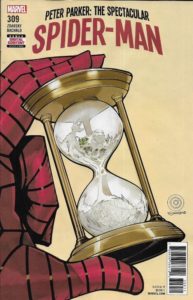 and one with the responsibility), but, like FF, managed to present it effectively and well, with a couple of thoughtful themes and the reintroduction of a long-missed romantic relationship. The Ryan Ottley art is growing on me, too — you can see him gaining in confidence as he gets more issues under his belt. He’s got something of Sal Buscema’s clear, minimalist style, and Buscema had a long, successful Spidey-artist career, so there’s some cause for optimism. The other Spider-title, Spectacular Spider-Man, concludes a two-part Sandman story drawn by Chris Bachalo: reason enough to pick it up (and the previous one, still on the stands, if you want the whole thing); Sandman is a conflicted, tragic-enough figure to yield good stories, and Chip Zdarsky offers one here, with an effective final punch. Infinity Wars hits the halfway mark with Gamora holding the fully-charged
and one with the responsibility), but, like FF, managed to present it effectively and well, with a couple of thoughtful themes and the reintroduction of a long-missed romantic relationship. The Ryan Ottley art is growing on me, too — you can see him gaining in confidence as he gets more issues under his belt. He’s got something of Sal Buscema’s clear, minimalist style, and Buscema had a long, successful Spidey-artist career, so there’s some cause for optimism. The other Spider-title, Spectacular Spider-Man, concludes a two-part Sandman story drawn by Chris Bachalo: reason enough to pick it up (and the previous one, still on the stands, if you want the whole thing); Sandman is a conflicted, tragic-enough figure to yield good stories, and Chip Zdarsky offers one here, with an effective final punch. Infinity Wars hits the halfway mark with Gamora holding the fully-charged  Infinity Gauntlet and Loki playing the advisor/Mephisto/secret good guy role. The big deal is that she uses her powers to “fold the universe in half,” which leads to an Amalgam-like new timeline yielding a bunch of two-issue mini-series over the next month: Soldier Supreme, for example, is a mashup of Captain America and Doctor Strange; Weapon Hex is a Wolverine/Emma Frost combo; Arachknight is Spider-Man/Moon Knight, etc., etc. Two issues each seems about right for those: enough to play with the new toys without getting boring; whether it’ll be seen as a bunch of cool concepts or a cynical money-grab will depend on the execution, but the Mike Deodato Jr. art here makes them look exciting enough to my 12-year-old inner fan.
Infinity Gauntlet and Loki playing the advisor/Mephisto/secret good guy role. The big deal is that she uses her powers to “fold the universe in half,” which leads to an Amalgam-like new timeline yielding a bunch of two-issue mini-series over the next month: Soldier Supreme, for example, is a mashup of Captain America and Doctor Strange; Weapon Hex is a Wolverine/Emma Frost combo; Arachknight is Spider-Man/Moon Knight, etc., etc. Two issues each seems about right for those: enough to play with the new toys without getting boring; whether it’ll be seen as a bunch of cool concepts or a cynical money-grab will depend on the execution, but the Mike Deodato Jr. art here makes them look exciting enough to my 12-year-old inner fan.
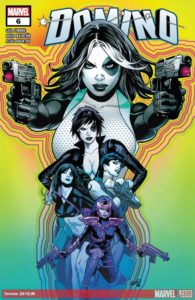 Domino #6 — Writer: Gail Simone; Art: David Baldeon; Colors: Jesus Aburtov
Domino #6 — Writer: Gail Simone; Art: David Baldeon; Colors: Jesus Aburtov
Champions #24 — Writer: Jim Zub; Art: Sean Izaakse; Colors: Marcio Menyz and Erick Arciniega
Runaways #13 — Writer: Rainbow Rowell; Art: David Lafuente; Colors: Jim Campbell
The Unbeatable Squirrel Girl #36 — Writer: Ryan North; 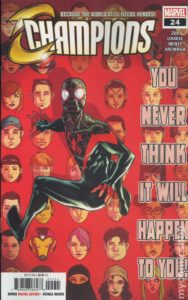 Art: Derek Charm; Colors: Rico Renzi
Art: Derek Charm; Colors: Rico Renzi
All four of these last Marvel books are well-told stories that offer something beyond the usual super-powered fighting and angst. Domino ends its first story with lessons learned and powers refined and supporting cast firmly in place; Gail Simone’s made it a good mix of humor and drama, with a refreshing underlying toughness, and David Baldeon’s art covers both action and 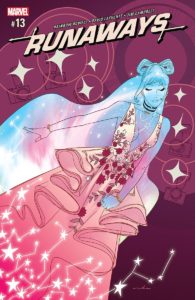 emotion well, and makes us care about Domino and her friends: this book may stick around a while. Champions does a “very special issue” on high-school shootings, and it’s not stupid or pandering, and doesn’t allow for easy answers; the group of kids at its core struggle through guilt and frustration to get to a semi-optimistic place, just like real-world kids. Runaways keeps knocking it out of the park; last issue concluded its second volume with romantic
emotion well, and makes us care about Domino and her friends: this book may stick around a while. Champions does a “very special issue” on high-school shootings, and it’s not stupid or pandering, and doesn’t allow for easy answers; the group of kids at its core struggle through guilt and frustration to get to a semi-optimistic place, just like real-world kids. Runaways keeps knocking it out of the park; last issue concluded its second volume with romantic 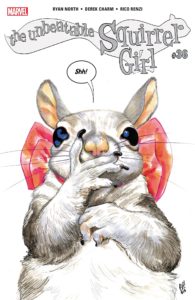 relationships within the group, and was quietly heartfelt, while this week begins its third arc with a lot more flash and bang, including the return of Alex Wilder, pursued by alien overlords, and, finally, the full group together and ready to kick some butt. Unbeatable Squirrel Girl does a mostly-all-silent issue (appropriately so, since it’s about a ghostly librarian); that gives Derek Charm’s art a chance to show off its narrative skill. It’s a typically-clever and appealing one-shot story that’s a great jumping-on point: exactly why this comic has become such an ambassador to the non-comics-reading civilian world.
relationships within the group, and was quietly heartfelt, while this week begins its third arc with a lot more flash and bang, including the return of Alex Wilder, pursued by alien overlords, and, finally, the full group together and ready to kick some butt. Unbeatable Squirrel Girl does a mostly-all-silent issue (appropriately so, since it’s about a ghostly librarian); that gives Derek Charm’s art a chance to show off its narrative skill. It’s a typically-clever and appealing one-shot story that’s a great jumping-on point: exactly why this comic has become such an ambassador to the non-comics-reading civilian world.
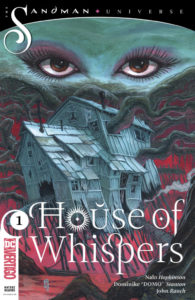 House of Whispers #1 — Writer: Nalo Hopkinson; Art: Domo Stanton; Colors: John Rauch
House of Whispers #1 — Writer: Nalo Hopkinson; Art: Domo Stanton; Colors: John Rauch
Catwoman #3 — Writer: Joelle Jones; Art: Jones and Fernando Blanco; Colors: Laura Allred and John Kalisz
Superman #3 — Writer: Brian Michael Bendis; Pencils: Ivan Reis; Inks: Joe Prado and Oclair Albert; Colors: Alex Sinclair
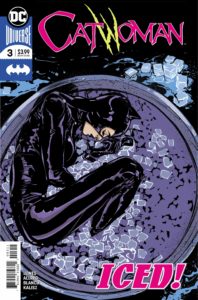 Plastic Man #4 (of 6) — Writer: Gail Simone; Art: Adriana Melo; Colors: Kelly Fitzpatrick
Plastic Man #4 (of 6) — Writer: Gail Simone; Art: Adriana Melo; Colors: Kelly Fitzpatrick
Detectice Comics #988 — Writer: James Robinson; Art: Stephen Segovia; Colors: Ian Plascencia
House of Whispers, one of the new Vertigo “Sandman Universe” launches, is about a Louisiana houseboat inhabited by voodoo practitioners, and some of the loa 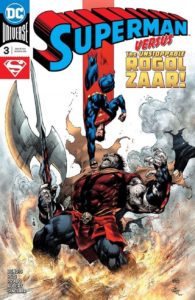 themselves; people in trouble petition the crew through their dreams, which leads to an inter-dimensional kerfuffel and the houseboat getting marooned in The Dreaming. This first issue is mostly character introduction and world-building (the “whispers” aren’t mysteries or secrets, like the other two houses in The Dreaming; they’re rumors); Nalo Hopkinson, who’s a Jamaican-born sf novelist, gives it a knowledgeable and skillful start. Catwoman has Selina in the city of Villa Hermosa, running afoul of the crime family
themselves; people in trouble petition the crew through their dreams, which leads to an inter-dimensional kerfuffel and the houseboat getting marooned in The Dreaming. This first issue is mostly character introduction and world-building (the “whispers” aren’t mysteries or secrets, like the other two houses in The Dreaming; they’re rumors); Nalo Hopkinson, who’s a Jamaican-born sf novelist, gives it a knowledgeable and skillful start. Catwoman has Selina in the city of Villa Hermosa, running afoul of the crime family  that runs it; as usual, there’s lots of beautiful people behaving badly, something that Joelle Jones is very good at drawing. Superman has Earth stranded in the Phantom Zone, with the Justice League trying to hold it together and Rogol Zaar pulling together an invading army as a welcoming committee; it’s like new scripter Brian Bendis wanted to take the biggest cliche about his comics — that they’re too much just people standing around talking — and turn it on its head. Ivan Reis handles the big splash-page action and dozens-of-characters scenes and makes them look easy. Checking in
that runs it; as usual, there’s lots of beautiful people behaving badly, something that Joelle Jones is very good at drawing. Superman has Earth stranded in the Phantom Zone, with the Justice League trying to hold it together and Rogol Zaar pulling together an invading army as a welcoming committee; it’s like new scripter Brian Bendis wanted to take the biggest cliche about his comics — that they’re too much just people standing around talking — and turn it on its head. Ivan Reis handles the big splash-page action and dozens-of-characters scenes and makes them look easy. Checking in 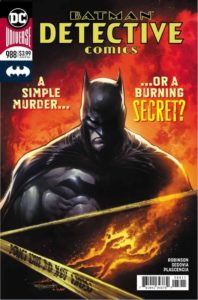 on the other Worlds Finest partner, Detective gets away from its previous Batman-heading-a-group plots into a solo story that sees the Darknight Detective investigating an old-fashioned murder mystery, one that leads to a C-list villain and another last-page real-bad-guy reveal, and is a good jumping-on point for new readers. Plastic Man is Gail Simone again, getting mileage out of having Plas fight her old Secret Six crew, as both the action and the drama ramp up; an even-bigger group of actual bad guys also show up on, you guessed it, the last page, emphasizing one of the biggest principles of serialized comics — to always give readers a reason to show up for the next installment.
on the other Worlds Finest partner, Detective gets away from its previous Batman-heading-a-group plots into a solo story that sees the Darknight Detective investigating an old-fashioned murder mystery, one that leads to a C-list villain and another last-page real-bad-guy reveal, and is a good jumping-on point for new readers. Plastic Man is Gail Simone again, getting mileage out of having Plas fight her old Secret Six crew, as both the action and the drama ramp up; an even-bigger group of actual bad guys also show up on, you guessed it, the last page, emphasizing one of the biggest principles of serialized comics — to always give readers a reason to show up for the next installment.



